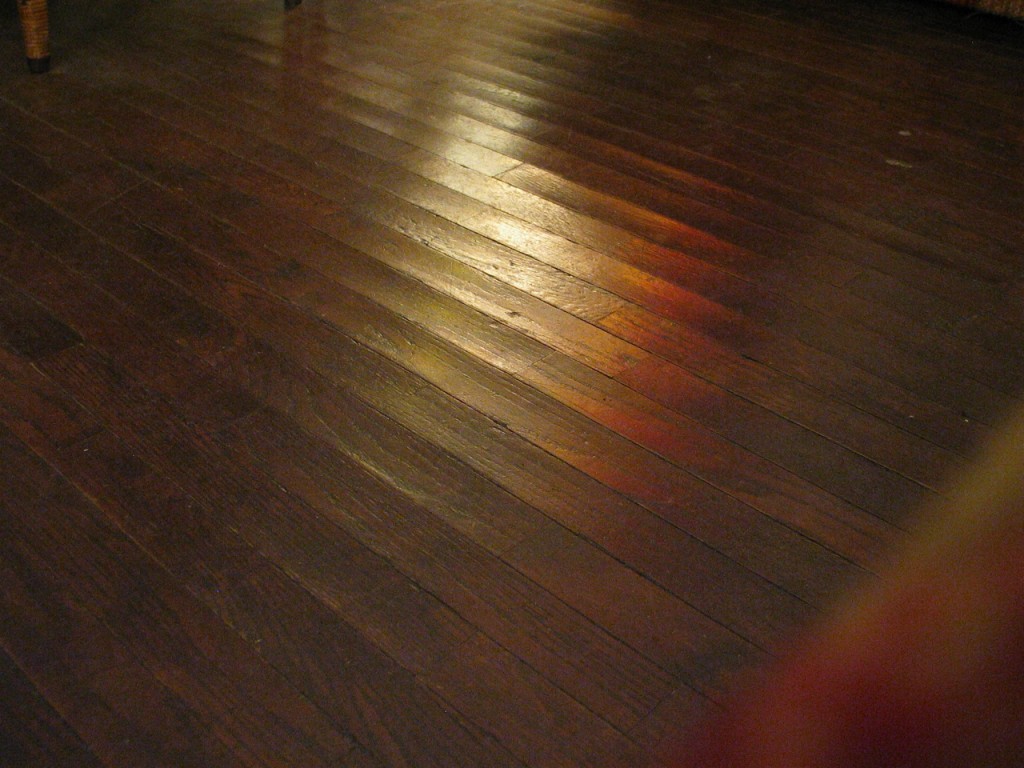We may receive a commission when you use our affiliate links. However, this does not impact our recommendations.

Second story oak floor wet mopped for many years. Every board is cupped. Pin this on Pinterest!
Water causes wood to swell, so most people think that wetting one side and not the other will cause the wetted side to bow – that is, increase in width so the center is higher than the edges.
If the wood is thin enough, this will be the case initially. But the overall swelling or shrinking after many wettings and dryings out, no matter the thickness of the wood, will be the opposite.
The wetted side will shrink and the wood, or boards, will cup. The four accompanying pictures show examples of this. With a little thought, you will most likely come up with examples from your own experience.
The explanation is a phenomenon called “compression set” or “compression shrinkage.” When one side of wood is wetted the wood cells want to swell. If the thickness of the wood prevents them from doing this, they compress from cylinder shapes to oval shapes, and they don’t return fully to their cylinder shapes when the wood dries out.
The compressions are cumulative. So, after many wettings and drying outs, the result is shrinkage. Eventually, the wood can’t shrink enough on the wetted side, so it splits. On a deck, for example, this shows up first as small “checks,” or splits.
None of this has anything to do with heartwood or sapwood up, or plain-sawn vs. quarter-sawn. Nor does it have anything to do with finishing both sides. The continuously wetted side will be the side that shrinks.
This is the reason wood exposed to water on one side should be protected with a finish in good shape and thick enough so water can’t get through. It’s the reason deck stains and water repellants are not very effective, and it’s the reason the message of “Don’t Refinish,” from the “Antiques Roadshow” television program has been so destructive to our furniture heritage.
Editor’s note – You’ll find all of Bob’s books in our store: “Flexner on Finishing” and “Wood Finishing 101.”
Here are some supplies and tools we find essential in our everyday work around the shop. We may receive a commission from sales referred by our links; however, we have carefully selected these products for their usefulness and quality.










Hello Bob, I have a major bathroom redo coming up very soon. I plan on building all new cabinets and trim using cherry lumber. I am not new at this but in a bathroom with all the moisture I had planned on finishing everything 100%, with three coats with Valspar marine varnish. I’m always looking for suggestions to ponder before deciding for sure on a project like this. There will be a lot of time and money in the project to be messing up on the finish work. Thanks for any help or suggestions you might have. Mike
I did not know this. Thanks for the helpful information. My pressure-treated deck went down 2 years ago. Is it too late to apply a protective finish? If not, is a spar varnish an appropriate way to treat it? Should I pressure wash it first?
That is another great lesson from the best expert. Thanks a lot Mr Flexner.
Having been a sailor for many years, I can certainly vouch for this opinion.
Thank You Bob